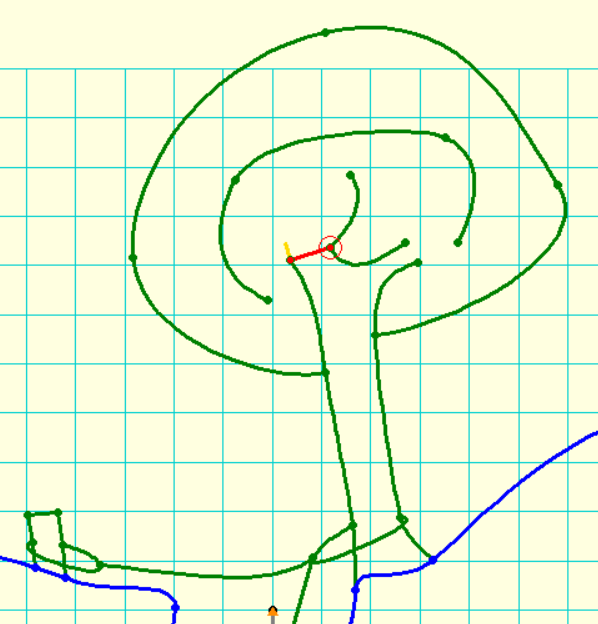This is an old revision of the document!
Rigging topos
This article is based on the traditional rigging topo approaches and styles used in the UK. However, it is likely be to very similar to approaches used elsewhere, and the approaches can be adapted. The symbols used here were almost entirely made especially for the purpose of making rigging topos. The sample rendering shows a series of both explicit naturals (stalagmites, colums, flakes, boulders, trees, stakes, bars) and symbolic naturals (circle), explicit P-hangers and implicit hanger dots:

Rigging topos (rigging diagrams) would usually start their life as a projected elevation (see the Therion book for details). The walls can be drawn with regular wall lines. The surface can be drawn with whatever lines are appropriate (the example shows wall lines with “-subtype sand -outline none -clip off”), with linepoints to connect stakes and trees.
The ropes are drawn with “rope” lines, using Simplified rope lines. This is because the default Therion “rope” line tries to look pretty, but in doing so, it loses the control of what linepoints should just be corners rather than rebelays and what linepoints should have anchors. It has an all-or-nothing approach, which is not useful in a rigging topo, where each rope corner and anchor must represent an actual situation. In addition, the normal rope line often fails to draw all the rope parts (some go missing at the end of a line). The line can be turned into a rather thin line by enabling the “rebelays off” and “anchors off” option of at least one linepoint along the rope, but this is clumsy, and relies on you not editing it and accidentally removing it. The simplified rope lines code solves all these problems at once, by making a thick rope line that just behaves like any other basic line.
Each kink in the rope (like at the deviation) is created with a line point. Each rebelay curve is created with a line point just before it, with the » directional control enabled, and dragged to an appropriate point. The rebelay point has the line's « directional control enabled and dragged to an appropriate position to create the curve. The » is not enabled. For traverses, the « and » are both enabled, but without enabling the “smooth” option. Y-hangs are created with the rope continuing from one anchor point to the centre of the Y-hang, then down the pitch, while a second line is used for the other side of the Y-hang.
The hangers are created with P-hangers that face the right way, and other anchor designs. The “p” P-hanger version is used where it must attach perfectly to the walls in the aven to the right. The “ropedp” version is used for the P-hangers that are attached to a rope. The “fixed” version is used to represent any kind of hanger with a dot symbol, and the “natural” version is used to represent any natural belay with a circle.
The initial stake and bar are created with Shoring lines, with extra points to attach the tethers to.
The tree is created with Trees; 3 treetrunk and 4 bush lines. The trunk has linepoints on either side, used to attach the tether, and then further points to attach the bush.

Important features that will be encountered are drawn with rock border and rock edge lines. The drilled flake is made from a rock border for both the edge and the hole, with linepoints on each to connect the tether to. The stalagmite and column are made from rock borders (after all, that is basically what they are, so it is accurate), with extra line points used to connect the tether. The boulder, of course, is also made from a rock border, with points to connect the tether.
Tethers/slings are made with a rope line. It is curved with the usual bezier curve controls, with its first linepoint at one side of wherever it passes behind an object, a second linepoint wherever the rope must connect to it, and a final linepoint wherever it passes back behind the object. This approach means the rope can connect perfectly to it, and it always looks perfectly like it passes behind an object without gaps or rendering mistakes.

The deviation is made from Deviations line, starting at the flake's tether, and ending at the main rope's linepoint.
The traverse ledge is made with Pit lines that look different in elevation view.
The rope lengths are made with Rope lengths points.